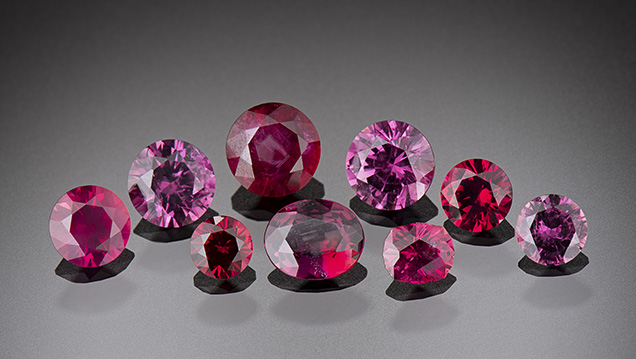Rubies from Rock Creek, Montana

North America has several productive colored stone deposits, from gem tourmaline in Maine and California, to emerald in North Carolina, to peridot, turquoise, and opal in the Western states. One gap in all of this gemological wealth is the virtual lack of any American ruby sources, with the exception of a minor deposit in North Carolina (G.F. Kunz, Gems & Precious Stones of North America, Dover Publishing, Mineola, New York, 1968, 367 pp.). This is surprising given the number of geographic locales in the American West named after the red variety of corundum (i.e., the Ruby Mountains of Nevada and the “Ruby Peaks” found in several states). In his epic tome Yogo: The Great American Sapphire (1987), Stephen M. Voynick provides an explanation for this apparent geographic contradiction. He proposes that early prospectors named these sites after stumbling upon garnets and mistaking them for rubies. Their vision also may have been clouded by dreams of wealth and hopes of striking a rich gem deposit. But what if there is some shred of truth to the old prospectors’ tales?
This journal recently described a ruby submitted to GIA with gemological properties that clearly indicated a Montana origin (Winter 2018 Lab Notes, pp. 434–435). Additionally, Palke et al. (2018) noted the occurrence of rare rubies and violet sapphires from Yogo Gulch (“A common origin for Thai/Cambodian rubies and blue and violet sapphires from Yogo Gulch, Montana, USA?” American Mineralogist, Vol. 103, No. 3, 2018, pp. 469–479). Over the course of several years, Jeffrey R. Hapeman (Earth’s Treasury, Westtown, Pennsylvania) has amassed a unique collection of true rubies from Potentate Mining’s operation at Montana’s Rock Creek deposit. According to Hapeman and Potentate’s Warren Boyd, rubies were only recovered when the miners were asked to put aside anything that resembled a garnet so they could be examined more carefully. Presumably, many rubies had been discarded as garnets in years past. Regardless, rubies from this deposit are extremely rare. To date, only 29 rubies—just over 6 grams—have been found in more than 400 kilograms of mine production.
Nine faceted Montana rubies from 0.172 to 0.578 ct (figure 1) and seven rough rubies from 0.11 to 0.34 grams, supplied by Mr. Hapeman, were included in this study. Additionally, 10 pink, blue, and green sapphires from Hapeman and 15 from GIA’s reference collection, gathered on-site at the Potentate mine, were used for comparison with the rubies. Standard gemological testing of several of the rubies with a handheld spectroscope yielded chromium spectra. The stones displayed weak to moderate red fluorescence in long-wave UV and no fluorescence under short-wave UV. Microscopic examination showed inclusion scenes resembling those of typical Montana sapphires, including crystalline or glassy melt inclusions surrounded by decrepitation halos (figure 2, left). Also common were angular particulate bands, often arranged in partial hexagonal patterns following the crystallographic orientation of the host corundum (figure 2, center). These bands are composed of loosely to densely spaced particles, short to long needles, and/or reflective platelets (figure 2, right). These features are consistent with material from the secondary Montana sapphire deposits at Rock Creek and the Missouri River. Similar inclusion scenes were also observed in the blue, green, pink, and purple sapphires from this study (figure 3).


The rubies were analyzed by laser ablation–inductively coupled plasma–mass spectrometry (LA-ICP-MS) to uncover their trace element patterns for comparison with the blue, green, pink, and purple sapphires from Montana also studied here. Generally, the rubies had trace element profiles of 13–38 ppma Mg, 16–81 ppma Ti, 1–27 ppma V, 408–2400 ppma Cr, 1106–2958 ppma Fe, and 11–20 ppma Ga with averages of 24 ppma Mg, 31 ppma Ti, 8 ppma V, 979 ppma Cr, 2123 ppma Fe, and 15 ppma Ga. Except for Cr, these values are consistent with the general ranges of pink/purple and blue/green Montana sapphires shown in the supplementary table 1. This is seen more easily in a Cr vs. Ga plot, which exhibits a continuous and seamless transition in Cr values increasing from the blue/green sapphires through the pink/purple sapphires to the true red rubies (figure 4). Additionally, plots not involving Cr tend to show similarities in the trace element chemistry of all other elements between Montana rubies and pink/purple and blue/green Montana sapphires. Figure 5 shows this similarity; it also compares these data against sapphires from a select number of globally important sapphire deposits. Figure 5 suggests that, except for Cr, the trace element profiles of Montana rubies and sapphires are the same, especially in comparison to other global sources of gem corundum. The rubies and pink/purple sapphires have a slight tendency toward lower Mg values, although it is unclear if this is statistically valid or a result of the small sample size. The trace element Cr appears to operate independently of most of the other trace elements and can vary more than four orders of magnitude, which is unheard of for the other trace elements in Montana sapphires. While further research may elucidate these geochemical mysteries, these unusual stones are a testament to the unique corundum produced at Rock Creek.



.jpg)


